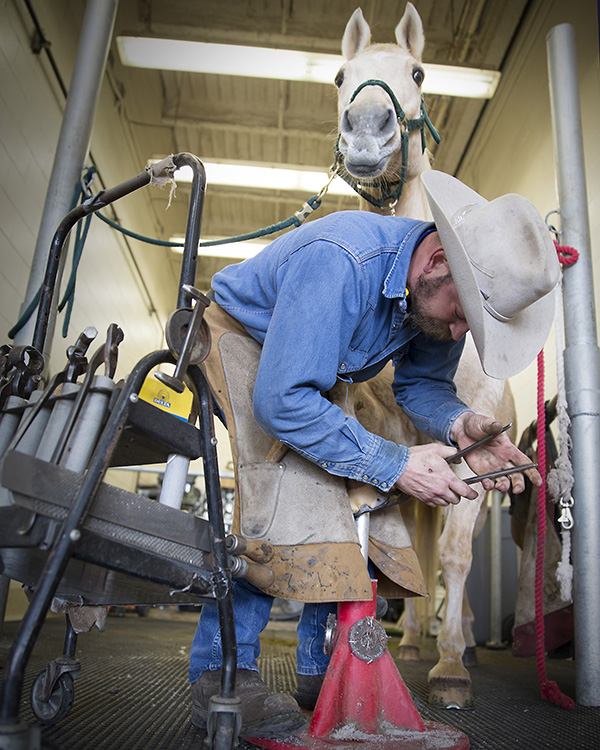Don’t Horse Around When it Comes to Hoof Care
 Proper hoof care is essential for a horse to be comfortable and active. Comprising a large part of horse veterinary care, the maintenance of horses’ feet is performed by a farrier, a skilled tradesman who specializes in equine shoeing and other hoof-related issues.
Proper hoof care is essential for a horse to be comfortable and active. Comprising a large part of horse veterinary care, the maintenance of horses’ feet is performed by a farrier, a skilled tradesman who specializes in equine shoeing and other hoof-related issues.
Jason Maki, the farrier at the Texas A&M College of Veterinary Medicine & Biomedical Sciences, regularly trims and maintains horses’ hooves. He said that improper hoof care can have serious consequences, so it is important that horses see experienced farriers.
“The symbiotic relationship between horses and humans is thousands of years old,” Maki said. “Farriers have been trimming and shoeing horses the entire time.”
Farriers should be experienced at trimming hoof growth, as well as creating, modifying, and applying any braces or supports a horse may need. Some horses may only need simple horse shoes, while others require surgical shoes with removable plates or braces.
“What might be needed for the horse’s comfort, usefulness, or recovery varies from horse to horse and situation to situation,” Maki said. “The ability to ascertain these needs and meet them is the hallmark of a skilled farrier.”
How often a horse needs to see a farrier varies from animal to animal. He said that cold weather slows hoof growth rates, so horses may not need hoof care as often during the winter.
There are also normal variations between different horses. For example, athletic horses tend to grow their feet faster than sedentary horses.
“Some animals require an every-four-weeks schedule, while others may be well into the seventh or eighth week before attention is needed,” Maki said. “An important point to remember is that excessive growth will cause the hoof to deteriorate; therefore, more frequent work is better than allowing hooves to grow long.”
Hoof trimming also is necessary to prevent other foot distortion problems; poor hoof care can make horses more prone to injuries and can cause fungal infections, sole bruises, or abscesses of the hoof.
“Untrimmed or poorly trimmed feet are prone to flaring, chipping, and hoof defects,” Maki said. “These all reduce the effectiveness of the hoof in bearing the weight of the horse.”
Farriers also work to provide horses with shoes for protection, traction, comfort, or other special needs. Maki said that farriers must be able to select and fit the perfect shoe for each horse, as an improper shoe will be less effective and may even harm a horse’s overall health.
“The role of the farrier in the human-equine relationship is to provide the best hoof a horse can have and then provide that animal whatever is required to perform its job comfortably,” he said.
Although shoeing horses is a large part of a farrier’s job, Maki said shoes are not necessary for every horse and that he evaluates each individual horse’s need on a case-by-case basis.
“If an animal can work and live well without horse shoes, then he should be barefoot,” Maki said. “The horse should be provided with what is needed for his comfort and usefulness. That is our obligation to the animals we are partnered with.”
Pet Talk is a service of the Texas A&M College of Veterinary Medicine & Biomedical Sciences. Stories can be viewed on the web at vetmed.tamu.edu/pet-talk. Suggestions for future topics may be directed to editor@cvm.tamu.edu.


